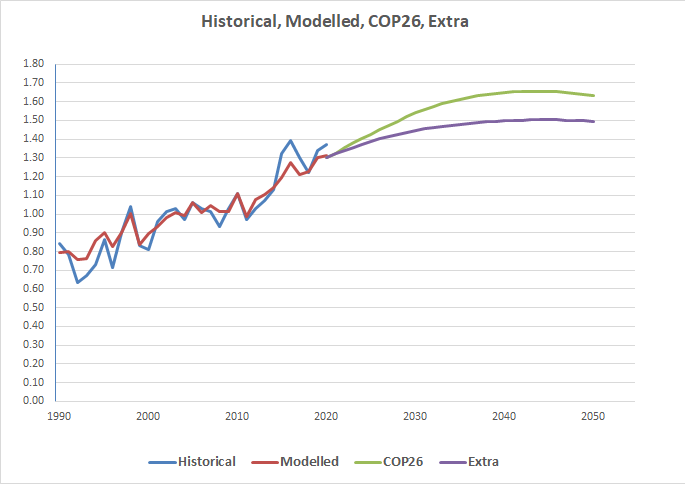COP26 can be a success if it changes the rules so that they drive the actions that need to be taken. A couple of the current rules are a hindrance to achieving the outcome that is required.
The real aim of this conference is to set in place a situation where global average temperatures since industrialisation are held to +1.5C. Yet there is a danger that this aim will be lost by mantra of reducing CO2e emissions to net zero by 2050. This mantra cannot be achieved except by burying vast amounts of CO2 underground. This will be a very expensive operation, being one that also adds an additional level of risk for future generations. It is also a diversion from the real action, which should be capping or reducing the atmospheric level of greenhouse gases.
The net zero objective is not built around the “real aim” of the conference, but seems to be designed to encourage nations to take actions that it is hoped will achieve that “real aim”. Yet there are other direct actions that will really work to achieve that aim. Why are these not being taken instead of the risky “bury CO2” strategy that is being proposed by the UK? Perhaps nations are being held back by two rules that hide the real impact of their actions and encourage them to take the wrong actions.
The consumption of coal for all purposes has been relatively stable, so why is it still being demonised, whereas nothing is said about the growing use of natural gas. For coal use analysis, check out this page! We will look at natural gas in the next section.
New Methane rule at COP26
The biggest hindrance to achieving a cap of +1.5C is the continuing growth in the atmospheric level of methane. This is almost entirely due to the continuing increasing growth of the consumption of natural gas, as can be seen here.
Part of the reason for this growth has been the demonising of coal, as well as an IPCC rule that serves to mask the immediate impact of the increasing use of this gas on global average temperature.
Natural gas has been cited as a “transition fuel”. This has been a false promise since the main outcome has been to delay the move to a new fuel economy for electricity generation. Worst still, for the first five years, even with old style coal-fired generation, it could have increased the global average temperature (with the normal amount of fugitive emissions associated with natural gas). It is even worse if coal-fired generators with the new HELE technology were used instead of natural gas.
The immediate problem with the IPCC rule for methane is that it estimates the lifetime impact of methane, but in doing so, it hides the immediate impact. This serves to make natural gas a better option than burning coal and hides the fact that it is significantly worse in early years.
The longer term problem with the IPCC rule for calculating CO2e emissions is that it fails to take into account the benefit from cutting methane emissions. The bizarre result is that methane emissions can never reach zero, even if the atmospheric level of methane is rapidly falling. This is nuts. It means that the current method of calculating CO2e for methane can and must be changed.
A more realistic approach would be to measure the immediate impact of methane emissions, taking into account the actual emissions in the current year to which can be added the climate impact of all previous emissions. This can easily be handled by adding up the emissions that have not yet decayed to the present emissions. This is not a hard task.
For each year the balance not yet decayed can be calculated by multiplying the estimated emissions for that year by a transition factor of 0.925 raised to the power of the sum of years before the current year + 0.5. Add these up for all years starting from 1990, when numbers were first established, until the present. Finally, deduct the total calculated so far with the total calculated for the previous year using the same methodology. The result can be positive or negative. Convert this value, as a value for methane, to CO2e, using the relative forcing for each gas and the relative percentage of each gas finding its way into the atmosphere, as determined by the IPCC. It is simple! It just needs a new rule.
Burning trees to make electricity
At present, under IPCC rules, it is allowed to burn trees to make electricity but to exclude the CO2 produced by this process on the assumption that these trees will be eventually replaced some decades later.
It is like “legal tax avoidance”. Burning trees does have an impact on the CO2 emissions in that year and thus it should not be excluded. If required, the regrowth can be deducted when it happens to the degree that it has happened. This can be allowed to the country that does the regrowing.
This is a rule that is crying out to be changed in the way described.
Setting targets at COP26 is not enough
Our long-term ambition should be that electricity generation in the future will consist of intermittent plus storage plus a backup generating source when these two cannot deliver.
We know that intermittent supply of electricity, via renewables, is better for the environment than using fossil fuels, but they endanger security of supply. Therefore, it should be an agenda item to discuss how 100% renewables can be used with confidence in regard to the security of supply. Yes we know that storage can manage normal fluctuations in supply, but we have no path forward for security of supply when wind and sun do not deliver as expected.
COP26 could call upon all nations to set out their plans for managing supply security when fossil fuels are removed from the equation. At present there are options available for providing some measure of security of supply using either coal or nuclear. We would all benefit from learning what other nations are planning to do.
Fully EVs are a leap too far for many nations
It will be possible to cut fossil fuel use for cars by as much as 60% by simply favouring the electric options: EV, PHEV and hybrid. Yet it would seem that battery costs are too high for everyone to have an EV, even in developed nations. Perhaps they will fall in price over time, but potential supply shortages of components for electric motors and batteries may bring that dream to an end.
Certainly, COP26 could suggest that nations take a more modest approach and include PHEVs and hybrids in their favoured options, rather than setting a too-high target and not finding the cuts in oil-based fuels that they desire due to a poor take-up of fully EVs.
HCFC-22
This gas is now a very serious greenhouse gas in its own right. If possible, it should be removed from all new refrigerators and industrial processes by 2023.
A report on the progress of the implementation of the Montreal Protocol for this gas can be expected at COP26, but one wonders whether significant progress has been made.
A successful outcome
If COP26 is nothing more than simply setting targets, as appears to be currently envisaged for COP26, we can expect that global average temperature will be +1.5C before 2030, with greater than +1.6C reached by 2040. The trend of data suggests that this is almost inevitable, given the past history of the linking of emissions and temperatures. Fluctuations due to ENSO and volcanos will see results around ± 0.1C, or more, occasionally appear,
However, if the extra actions proposed here are initiated at this conference, it should be possible to limit global average temperature growth to 1.5C out to 2050 (subject to the same yearly fluctuations of ± 0.1C ). After this date, temperatures will fall marginally.

Time will tell whether these simple to implement rule changes and removing the impediments to more drastic action will bring about the improvements I am predicting, but who will be brave enough to urge the nations to continue on the higher trajectory?
Now is the time for the leaders of the governments of the world to step up to the plate and make the changes suggested here. They cannot hurt.
